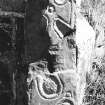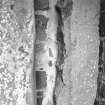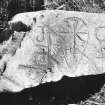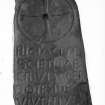Scheduled Maintenance
Please be advised that this website will undergo scheduled maintenance on the following dates: •
Tuesday 3rd December 11:00-15:00
During these times, some services may be temporarily unavailable. We apologise for any inconvenience this may cause.
Kirkmadrine Church And Burial-ground
Burial Ground (Early Medieval), Church (Early Medieval), Cross Slab(S) (Early Medieval), Gravestone(S) (Early Medieval)
Site Name Kirkmadrine Church And Burial-ground
Classification Burial Ground (Early Medieval), Church (Early Medieval), Cross Slab(S) (Early Medieval), Gravestone(S) (Early Medieval)
Alternative Name(s) Old Parish Church Of Toskerton; South Cairnweil; Mctaggart Memorial
Canmore ID 60441
Site Number NX04NE 1
NGR NX 08014 48389
Datum OSGB36 - NGR
Permalink http://canmore.org.uk/site/60441
First 100 images shown. See the Collections panel (below) for a link to all digital images.
- Council Dumfries And Galloway
- Parish Stoneykirk
- Former Region Dumfries And Galloway
- Former District Wigtown
- Former County Wigtownshire
Kirkmadrine 1, Wigtownshire, inscribed cross-slab
Measurements: H 2.01m +, W 0.40m expanding at the base to 0.66m, D 0.18m
Stone type: schist
Place of discovery: NX 08014 48389
Evidence for discovery: first recorded around 1810 in the old churchyard, recognised in 1860 in re-use as a gatepost at the entrance to the nineteenth-century graveyard enclosure, included in the first Ancient Monuments Protection Act of 1882 and taken into state guardianship in 1887. It was moved into a new porch outside the west end of the church when the ruins were restored in 1889-90. The porch was refurbished and the stone collection redisplayed in 2013-15.
Present location: at Kirkmadrine church.
Present condition: worn, and damaged at the top.
Description:
This pillar-stone bears an encircled chi-rho cross on both broad faces. On face A the arms of the cross are sunken and have expanded and dished terminals, with a deeper circular roundel at the centre. Above the cross are incised the letters A E, all that survives of the original inscription A ET W for ‘alpha and omega’. Below the cross are incised six lines of Latin, a memorial to two or possibly three priests. On face C there is a very similar chi-rho cross, except that there is no central roundel.
Date: sixth century.
References: Mitchell 1872; Stuart 1867, pl 71; ECMS pt 3, 494-5; Craig 1992, vol 3, 117-26, vol 4, pl 130.
Desk-based information compiled by A Ritchie 2019.
Kirkmadrine 5, Wigtownshire, cross-slab fragment
Measurements: H 0.47m, W 0.36m, D 0.12m
Stone type:
Place of discovery: NX 08014 48389
Evidence for discovery: found in the graveyard and built into the graveyard wall sometime before the 1880s.
Present location: at Kirkmadrine church.
Present condition: very weathered and the lower part of the slab is missing.
Description:
This is the upper part of a round-headed cross-slab, carved in low relief and incision on both broad faces. On one face there is an equal-armed cross with wedge-shaped arms and long bars in the armpits, and a central roundel within a diamond. Below are two smaller crosses with widely expanded arms, and all three crosses have an inner groove outlining their shape. On the other broad face there is a damaged hammer-headed cross, plain apart from an inner groove and a central roundel. There are circular roundels in the armpits.
Date: early medieval.
References: Craig 1992, vol 3, 137-8, vol 4, pl 136A & B.
Desk-based in formation compiled by A Ritchie 2019.
Kirkmadrine 2, Wigtownshire, inscribed cross-slab
Measurements: H 2.04m+. W 0.34m, D 0.30m
Stone type: schist
Place of discovery: NX 08014 48389
Evidence for discovery: first recorded around 1810 in the old churchyard, recognised in 1860 in re-use as a gatepost at the entrance to the nineteenth-century graveyard enclosure, included in the first Ancient Monuments Protection Act of 1882 and taken into state guardianship in 1887. It was moved into a new porch outside the west end of the church when the ruins were restored in 1889-90. The porch was refurbished and the stone collection redisplayed in 2013-15.
Present location: at Kirkmadrine church.
Present condition: worn and part of the inscription has flaked away.
Description:
A tall pillar-stone incised on one broad face with an encircled chi-rho cross and a Latin inscription. The cross has expanded terminals to the arms. The memorial inscription provided two personal names, of which only ‘Florentius’ survives. On face C there is an incised linear cross.
Date: sixth century.
References: Mitchell 1872; Stuart 1867, pl 71; ECMS pt 3, 494-5; Craig 1992, vol 3, 127-9, vol 4, pl 131.
Desk-based information compiled by A Ritchie 2019.
Kirkmadrine 3, Wigtownshire, inscribed cross-slab
Measurements: H 0.99m+, W 0.26m, D 0.23m
Stone type: schist
Place of discovery: NX 08014 48389
Evidence for discovery: first recorded around 1810 in the old churchyard at Kirkmadrine, and taken to Stoneykirk Free Church Manse in the mid nineteenth century, where it was re-used as part of a gatepost. It was retrieved in 1916 and taken back to Kirkmadrine to be displayed in the porch outside the west end of the church at Kirkmadrine. The porch was refurbished and the stone collection redisplayed in 2013-15.
Present location: at Kirkmadrine church.
Present condition: much damage had been inflicted on the stone when the gatepost at Stoneykirk was demolished, but the fragments were restored.
Description:
One broad face of this pillar-slab bears an incised encircled chi-rho cross and a Latin inscription. The cross has very slender arms which terminate in wide dished expansions. The inscription reads ‘the beginning and the end’.
Date: sixth century.
References: Mitchell 1872; ECMS pt 3, 494-5; Craig 1992, vol 3, 130-4, vol 4, pl 132.
Desk-based information compiled by A Ritchie 2019.
Kirkmadrine 4, Wigtownshire, cross-slab fragment
Measurements: H 0.60m, W 0.34m
Stone type:
Place of discovery: NX 08014 48389
Evidence for discovery: found by William Galloway in 1887 in re-use as a headstone.
Present location: at Kirkmadrine church.
Present condition: very worn, and the top of the carved cross is damaged.
Description:
This fragment forms the major part of a slightly tapering cross-slab, carved by incised grooving on one broad face only. The lower part of a hammer-headed cross is outlined by double grooves and is set on a large rectangular base, similarly outlined. Within the base, double lines form a saltire cross, and there is a small cross with barred terminals in each section of the saltire.
Date: early medieval.
References: Craig 1992, vol 3, 135-6, vol 4, pl 137A.
Desk-based information compiled by A Ritchie 2019.
Kirkmadrine 6, Wigtownshire, cross-slab fragment
Measurements: H 0.86m, W 0.16m, D 0.07m
Stone type:
Place of discovery: NX 08014 48389
Evidence for discovery: first recorded by RCAHMS around 1911.
Present location: at Kirkmadrine church.
Present condition: worn and trimmed on all four sides.
Description:
This tapering fragment is carved on one broad face with parts of three crosses, one above the other. They are carved in low relief by pecking the background and outlining with inner grooves. At the top is a large rectangular upper arm filled with angular interlace, above a central roundel and circular armpits. Very close below is another cross with widely expanded arms, itself almost touching another such cross below.
Date: early medieval.
References: Craig 1992, vol 3, 139-40, vol 4, pl 136C.
Desk-based information compiled by A Ritchie 2019.
Kirkmadrine 7, Wigtownshire, cross-slab
Measurements: H 0.87m+, W 0.25m, D 0.15m
Stone type:
Place of discovery: NX 08014 48389
Evidence for discovery: found in the mid nineteenth century in re-use built into a dyke near the graveyard.
Present location: at Kirkmadrine church.
Present condition: very worn and part of the right-hand side is missing.
Description:
This is the major part of a massively proportioned slab, carved on one side only by deeply pecked grooves. The upper part of the slab is filled by an outline cross with a central double-grooved oval roundel, on which there was once ornament but it is now very worn. In the background there are patterns of grooved lines, and below the cross are three grooved lines.
Date: early medieval.
References: Craig 1992, vol 3, 141-3, vol 4, pl 137D & E.
Desk-based information compiled by A Ritchie 2019.
NX04NE 1 08014 48389
Kirkmadrine Church (NR)
OS 6" map (1909)
(NX 0801 4839) Ch. (NAT)
OS 6" map (1957)
A modern church now occupies the site of the parish church of the old parish of Toskerton now generally called Kirmadrine, which was united to Stoneykirk in 1618. The old church was dedicated to St Medran of Muskerry and belonged to Whithorn Priory.
Watson, however, considered that the dedication was to someone of the name, perhaps of Draigne or Drine. Radford suggests that the site was a place of importance, probably a monastery (published as such by the OS) in the early Christian period, as three 5th-6th century gravestones, which were noted by Todd in 1820 as standing in the burial ground surrounding the church, were later found two acting as gateposts to the burial ground while the third had been moved to form a gate-pillar of the Stoneykirk U F Church Manse. Other fragments of stones dating between the 8th-12th centuries have also been found at various times in the churchyard.
There is no sign at all, either from the air or on the ground, of any form of enclosed cemetery of early type at Kirkmadrine and it is supposed that the original position of the stones was elsewhere in the neighbourhood (see NX13NW 24). Stones under guardianship.
C A R Radford and G Donaldson 1953; H E Maxwell 1917; A C Thomas 1968
H Scott 1917; OS Dark Ages map 1965; R G Collingwood 1939; W J Watson 1926
The three 5th/6th century gravestones, together with fragments of several 8th-12th century cross slabs and gravestones, are in the porch of the church, which is no longer in use.
Visited by OS (RD) 9 September 1970
This church, which served the medieval parish of Toskerton, stood within its walled burial-ground on a low rise 410m S of South Cairnweil farmsteading. The site is occupied by a burial-aisle of the MacTaggarts of Ardwell which incorporates some earlier masonry, most noticeably at the E end, and may preserve the ground-plan of the former church (the aisle measures 12.7m by 5.6m within walls 0.9m thick).
Three Early Christian inscribed stones, and five cross-fragments which range in date from the 8th to the 12th century, found on, or near, the site, are displayed in the porch at the W end of the aisle.
The parish of Toskerton was united with Stoneykirk parish in 1618.
NSA 1845; Name Book; J Stuart 1867; A Mitchell 1872; G Chalmers 1887-1902; J R Allen and J Anderson 1903; P H M'Kerlie1906; RCAHMS 1912; 1985, visited 1984; H E Maxwell 1917; R G Collingwood1938; W D Simpson 1940; I B Cowan 1967; C A R Radford and G Donaldson 1980.
Publication Account (1986)
Displayed in a glass-fronted porch of a late 19th century burial chapel at Kirkmadrine are the oldest Christian monuments in Scotland outside Whithom. The most infonnative and oldest of the group, a pillar stone which dates from the 5th century, bears a six-line Latin inscription: 'Here lie the holy and chief priests (ie Bishops), Ides, Viventius and Mavorius', and, at the top, above a circled cross 'AClpha) and (Omega),. The incised equal-anned cross has a crooked loop on the upper ann, signifying the sacred chi-rho monogram. A similar cross and symbol are fonned on a second pillar, presumably of later 5th century date, which is more enigmatically inscribed '(Here lie) ... sand Florentius'. A smaller pillar stone has the Latin inscription, 'The beginning and the end', a variant of the Alpha and Omega symbol as defmed in Revelation 21:6. The fonn of the cross and the style of lettering suggest a date of around AD 600. The other funerary monument on display include fIve cross-fragments which range in date from the 8th to the 12th centuries.
When first discovered in the 19th century the three oldest pillar stones were serving as gateposts and as a stile-slab in the churchyard wall; the rest were found in the churchyard itself Collectively, they represent an early Christian cemetery of some importance in this neighbourhood. Unfortunately, nothing is otherwise known about the identity and authority of these bishop-priests; presumably they served Christian communities in this area, perhaps as an offshoot from Whithom (no. 79). The compound name, Kirkmadrine, implies a dedicatory saint, usually taken to be St Mathurinus, but the name is not recorded before 1500. The medieval parish was known as Toskerton and was united with Stoneykirk in 1618.Lady McTaggart Stewart of Ardwell had the chapel rebuilt in neo-Romanesque style out of the medieval ruins on the site, modelling it on Cruggleton (no. 70).
Information from ‘Exploring Scotland’s Heritage: Dumfries and Galloway’, (1986).
Watching Brief (14 January 2014)
NX 0800 4838 A watching brief was undertaken on 14 January 2014 during a minor excavation in the porch of the church ahead of the installation of a new floor. No finds or features of archaeological significance were recorded.
Archive: RCAHMS (intended)
Funder: Historic Scotland
David Murray – Kirkdale Archaeology
(Source: DES)
OASIS ID: kirkdale1-279202
Note (20 March 2024)
A ruined church and burial ground is depicted on the 1st edition of the OS 6-inch map (1850).
Information from HES (D Watson) 20 March 2024














































































































































































































